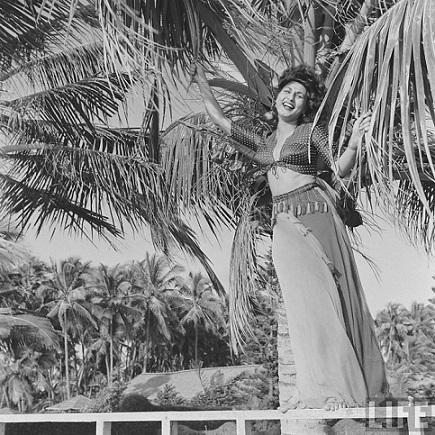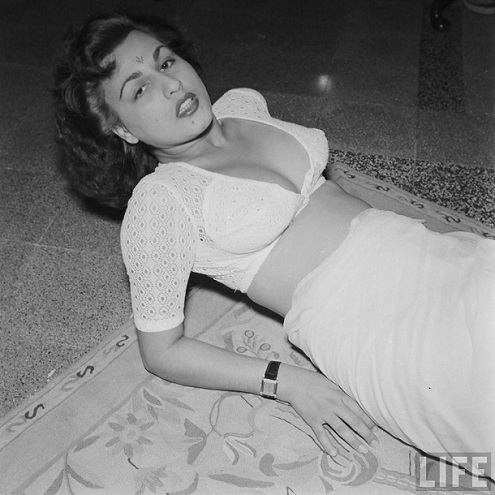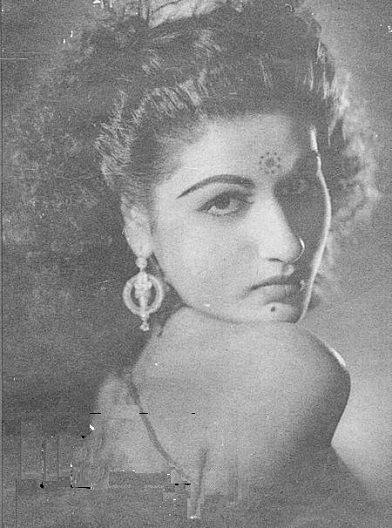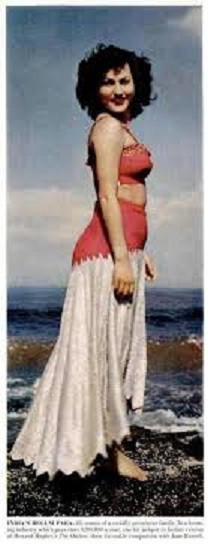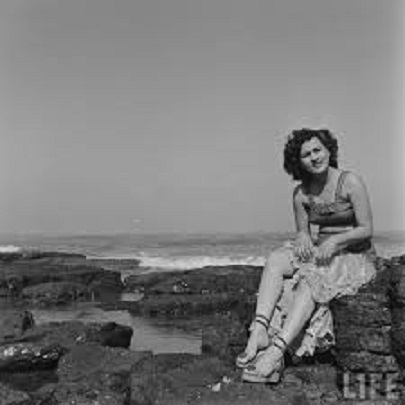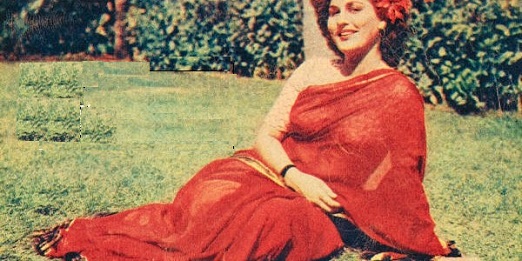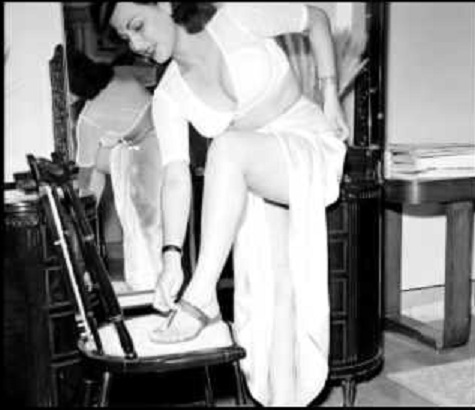Begum Para
This is a collection of articles archived for the excellence of their content. |
Contents |
Biography
Khalid Hasan: Begum Para: the last glamour girl, 02 Aug 2015, The Friday Times
Begum Para: the last glamour girl
Begum Para, who passed away in her sleep in Mumbai in December 2008, was born on Christmas day 82 years before, in Jehlum. Her father, Mian Ehsanul-Haq, was a judge who at some point in his life went into the judicial service of the princely state of Bikaner, now northern Rajasthan, where he became chief justice of its highest court. Although Begum Para never came to live in Pakistan, except after 1974 for some time when she lost her husband, the handsome actor Nasir Khan, Dilip Kumar’s younger brother, much of her family moved to Pakistan after 1947.
Her father was a fine cricketer of his time, a talent he bequeathed on his son. MU Haq, who was seen as a dead certainty for the 1954 cricket tour of England but, because of an unfortunate misunderstanding with Skipper Abdul Hafiz Kardar, was left out, an omission that broke his heart. Years later, MU Haq built himself a magnificent house in Karachi that he named “Midwicket.” He died earlier this year, mourned by all those who knew him and knew of his lifelong devotion to cricket and the great service he rendered to the promotion of the game, particularly in Karachi. The bitterness of the 1950s with Kardar must have gone mellow over time because in 1976 when I applied for a membership with the MCC, handing over my completed application to Skipper when he came on one of his visits to London, my proposer (I learnt only recently from MCC) was Asif Ali and my seconder MU Haq, both of course MCC members in good standing. MCC’s total number, I should add, is not allowed to exceed 15,000. Current membership waiting period: 30 years.
But to return to Begum Para, the land-owning family of her father came from Jullandhar, the city that has given birth to an amazing range of talented people. KL Saigol came from Jullandhar, as did Dr Jehangir Khan, the only cricketer to have felled a sparrow at Lord’s with one of his sizzlers. That shaheed-e-cricket bird is now immortalised behind a frame in the Long Room at Lord’s, along with the man who sent it to cricket heaven. Jullandhar also produced the stylish hockey player and even more stylish journalist, HK Burki. There is something to certain cities when it comes to the production of remarkable men. Take Amritsar, for example, when one thinks of literature. Consider the names and marvel: Saadat Hasan Manto, Bari Alig, A Hamid, Saifuddin Saif, Zaheer Kaashmiri, Ahmed Mushtaq, Shad Amritsari and Javed Shaheen, to name a few. And although he was not a poet, there has never been a political wit like Sardar Muhammad Sadiq, who also came from Amritsar.
In those days, Muslim girls from “respectable” families were not supposed to become actresses. That was a profession said to be the preserve of girls from the “bazaar.” But this incandescent beauty, Begum Para, was a rebel and once she got it into her head to join the movies, she was not to be stopped. As it was, she was already in Bombay, having gone there to visit her brother Madsrurul Haq and his actress wife, the dusky Bengal-born beauty, Protima Dasgupta. Bombay of those days was the magic city that all romantically-inclined youngsters from Indian towns, small and big, dreamt of running off to. I remember old Mir Muhammad Ali, owner of Shabeena Hotel, the only den of minor sin in Sialkot, saying, “I love the Quaid-e-Azam but what sort of country has he given us! There is nowhere for young boys to run to now.” When news that Judge Ehsanul-Haq’s daughter was in Bombay to become an actress, some saw it as a huge scandal and felt that it had brought embarrassment to the family. However, when the family realised that young Para was not to be dissuaded, it fell in line and did not stand in her way.
Begum Para managed to make it, given her smashing looks and her determination to become a star. She was not what may be called a “great” actress but she was a trooper. Her first movie, according to my film encyclopaedist friend Muhammad Rafiq in England, was the 1944 Prabhat production, Chaand, with Prem Adib playing her lead. This was followed by Chhamia a year later and then in quick succession: Shalimar and Sohni Mahniwal (1946), Duniya Ek Sarai,Lutera, Mehndi, Neel Kamal and Zanjeer (1947), Jharna, Shaahnaaz and Kidar Sharma’sSohag Raat (1948), Dada (1949), Meharbaani (1950), Ustad Pedro (1951), Laila Majnu, Naya Ghar (1953), Aadmi (1957) and Do Mastaane (1958). The three movies, Dada, Dara and Ustad Pedro starred Sheikh Mukhtar, the Anthony Quinn of Indian cinema, who played a Bombay street lord, with the T-shirt-wearing, ebullient Begum Para as his sidekick. These three movies were great hits. As happens in the hard-hearted world called the movies, Begum Para’s star was setting as new and different kinds of actresses, with more dramatic talent than looks, had emerged. Begum Para retired gracefully and never looked back. Everyone had forgotten who she was when, in 2007, she agreed to make her last movie, Sanwarya. She was very ill by then and would come to the set in a wheelchair but stay all day without showing any complaint. She would regale the cast with stories that dated back half a century, long, long before any of her listeners was born.
The family linkages of Begum Para are fascinating. He elder brother, Masrurul Haq, had gone off to Bombay in the late 1930s to become an actor. There he had met and fell in love with the comely Bengali actress Protima Dasgupta, who was born in Bhavnagar, Gujarat, in 1922. Begum Para’s older sister Zarina’s daughter Rukhsana Sultana is the mother of the Indian actress and show business personality Amrita Singh. Rukhsana Sultana married Shavinder Singh, the younger brother of the novelist Khushwant Singh, and the son of Sir Sobha Singh of Lahore. Begum Para’s son Ayub Khan is an actor and so is his wife Niharika, who played a faded movie star, with advice from her mother-in-law, in Khoya Khoya Chand.
She said, “I couldn’t give Niharika my own examples as I was not like the ‘good’ actresses. I always played negative, bold characters – would wear backless blouses, in those times it was quite bold.” In an interview last year after the release of her last film, which did not do well, Begum Para said, “I’m 80 now. It was a great experience working after so long. Although I must admit, I felt a bit anxious about facing the camera after so many years.” In another interview, she said, “I have millions of memories from those days. I didn’t smoke as I never liked it. But I did drink even when it was considered taboo. I used to hold a glass of whisky openly, unlike other actresses who mixed whisky in colas and pretended that they were teetotalers.” Talking about her contemporaries, she said, “I miss my friends Nargis, Geeta Bali, Nadira, Shyama, Motilal, Sitara Devi and Nilofer. We used to often meet and paint the town red. I’m also getting old now so the telephone is the only way to communicate.”
No one will disagree that here was a woman who lived life on her own terms and brought sunshine into the lives of millions of her fans, including those American GIs in Korea who would stick her picture on the cover of Life in their bunkers.
Autobiographical sketch
As told to Moni Mathai Singh, 1990
I was born as Para Haq, into a very illustrious family of Aligarh. My father was a minister with the government and we had a very disciplined yet liberal upbringing. I spent most of my growing up years in Bikaner and was educated at the Aligarh University. Since both my parents were highly educated people, they insisted on all their children being very accomplished academically. Do you know that my father and his family were the pioneers of cricket in India? Now you’ll ask me where does films fit into all this? Well it was purely pushing glamour from my side. You see, my brother happened to be married to Protima Das Gupta, a very famous actress of yesteryears. Whenever I visited them in Bombay, I was quite taken up with the glitzy world of my sister-in-law’s. I used to accompany her on many occasions to many filmi get togethers. At the cost of modesty, people would get quite impressed with my looks and offer me a lot of roles!
S.Mukherjee and Devika Rani, were among the people who offered me their films. When my father heard of it, he had no choice but to consent to my wishes reluctantly. But he only requested me one thing. That I’d never work in Lahore.
My first break turned out to be Chand, from Prabhat Studios in Poona. It was in the year 1944. Prem Adib was my hero, and Sitara Devi was the vamp in the film. It did extremely well and I started getting paid about Rs.1500 a month, which was a huge amount all those years ago! Soon after, my sister-in-law Protima and I made a film called Chamia based on the novel ‘Pygmalion’, which was again a huge success. I sort of arrived after this film. Though I signed a lot of films after Chamia, I didn’t quite establish myself as an actress. In fact, I never really did. Because I had a highly scandalous image, so people always gave me roles of glamour doll in most films! Not that I minded really. Because I always played myself on screen. I can’t even imagine me playing the Sati Savitri! That really would’ve been the biggest laugh! I was the only actress of those times, who never hid her drink in a Coke!
As for films, I did Mehendi with Nargis; Zanjeer and Sohni Mahiwal with Ishwarlal and Dikshit; Meherbani with Ajit; Suhaag Raat with Bharat Bhushan and Geeta Bali and Neelkamal with Raj Kapoor. Raj Kapoor and I shared a great rapport. He used to call me his ‘Bra’, short term for brother. And I used to call him ‘Big Bra’ in turn! Maybe because of my tomboyish image.
Recently, I met Krishna bhabhi at the airport for the first time after his death. And she told me that she remembered me fondly, her husband’s ‘Bra’, when she saw Neelkamal recently. Frankly speaking, I used to be quite blunt with him whilst he was alive. Recently I saw the cassette which Simi made on him and I was quite angry when he started spouting all these double standardized views on women, actresses, etc. I was so angry, that I started abusing him. Believe me, if he was alive, he’d have really got it from me!
Yes, Nargis was especially close to me. In fact, Geeta Bali, Shammi, Nimmi and all of us belonged to one group. We were all registered at the same studio and we used to have a lot of fun together. There was a genuine warmth between us. Nargis was a very warm human being. She was madly in love with Raj. In fact, she was willing to be his mistress for life. She was even seriously planning to build a bungalow near his house. But the relationship had deteriorated so much, that it was bound to break up whether Sunil Dutt had stepped into the picture or not. But that was the wisest decision she ever made in her life. Of all our contemporaries, Geeta Bali was the finest actress. Absolutely versatile.
I remember that I had refused to play Nigar Sultana’s role in Mughal-e-Azam, because it went against my image — rona-dhona. The prettiest of all, was undoubtedly Madhubala. Without make-up, she was a sight for sore eyes.
Affairs and me? Not really, because I had a lot of men friends with whom I was genuinely friendly. They were my drinking partners. K.N. Singh, Motilal, David, Shobhana Samarth and I, formed a clique. I was just like one of the boys. We were the people who introduced cricket to the film industry. I remember that David used to call me Don Bradwoman on the field! I was the most daring of the lot. On one occasion, because of a challenge, I approached the Prime Minister of Ceylon to have a drink with me on board a flight. His jaw dropped but he complied willingly. I also have something else to my credit. I am the only Indian actress who was selected by Life magazine to pose as a pin-up girl for them.
I met my husband Nasser, on the sets of a film that we were to do together. He was Dilip Kumar’s younger brother. Shammi who played cupid between us. At that time, he was already married. Though I tried hard to resist him, I just couldn’t. Honestly speaking, his marriage was already on the rocks when we met. His wife was an over-suspicious woman, and they were only sticking together because of their daughter. When Nasser asked me to marry him, though we were both Muslims, I refused to settle for being a second wife. Soon after they got divorced, we married. Ours was a hush-hush affair and only close friends attended it. One of the pacts between us was that I take over the care of his daughter, which I did right up to her marriage.
No, my famous ‘jhet’ Yusuf (Dilip Kumar), did not come to the wedding. I’ve never really got along with him. After a certain incident that took place between us many years ago, we couldn’t stand the sight of each other. Even now, you must see us filmis, how hypocritical we can be. When we meet each other, we always greet each other with bear hugs, as though we are long lost friends! So superficial really. Yusuf has changed drastically after his marriage. He has chosen to cut himself off from all his family, his own brothers and sisters. No, I’ve absolutely no problems with all my sisters-in-law, they’re all very nice women. The only problem has been Yusuf. His wife Saira? She and I can stand even less of each other, than Yusuf and I. The less said the better.
Our marriage had its ups and downs. Nasser was very possessive about me. I sometimes joke that if given a chance, I’d rather be his mistress than his wife. A mistress is pampered more and is allowed more freedom than the wife. We have three beautiful children between us. Nasser had this physical condition, where he began to lose all his hair and eyebrows prematurely. He really lost out on his career because of that. During the making of Ganga Jamuna, he wore a wig and got away with it. So he concentrated all his efforts on making films.
In 1974, we put every ounce of our finance into a film called Zid. It starred Sanjay Khan and Saira Banu. The film was almost complete and Nasser took his unit out of town for the last schedule in April. On May 2, I got a call from him, saying that he was finished with shooting and was coming home the next day. The next day, early in the morning, Nargis paid me a strange call early in the morning. After a while, she gently broke the news that my husband was dead. He had died early that day, of a massive cardiac arrest.
For a long time after that, I lived in a world of my own. Reality wouldn’t register on me. I started drinking heavily. We had invested every paise in Zid and when he died, we were financially finished. I had three mouths to feed and no one to turn to. But in the alcoholic state that I was in, nothing mattered, except sitting in my room and drinking throughout the day and night. You see, I had become so dependent on my husband, that my world just crumbled without him. A ray of sunshine came, when my sister came down and took me to Pakistan to my parents. We were there for two years during which time they were really a balm to me. I got the strength and moral support from my family, and developed enough confidence to come to Bombay and start all over again. I made a decision, that I’d never ask anyone for a helping hand. I’ve rented out a portion of the house and that’s how I’ve been surviving all these years.
During this bleak phase of my life, my family was my strength. My niece Rukhsana, was especially close to me those days. She’s a genuine human being and means the world to me. I have been fond of her since she was born. When my sister was visiting me in Bombay with Rukhsana who was barely one, I was so excited that I filled the house with toys and things for the child. I remember an occasion where I gave the child pneumonia, because I had bathed her in a tub with all kinds of bathing salts!
Dingy (Amrita) was a fat, pampered little brat. She was always defying her mother in everything. I remember that during the Emergency, we were staying with Rukhsana in Delhi. And in spite of strict warnings not to step out of the house, Dingu sneaked off with my son to the movies. I remember the absolute thunderstorm when Rukhsana discovered the fact in the evening!
Dingu is also just like her mom. Very frank, outspoken and warm-hearted. But unlike her mother, she is foul-mouthed. In fact, we both are. She’s a chip off the old block. You must see us together. We could put the sailors to shame! Well as for her love life, I’ve never interfered at all. But I am glad all the same, that Vinod Khanna is out of her life. Because it had upset her mother no end.
Today, I am a firm believer in God and miracles. God has saved me twice. From the manic depressive phase after I became a widow, and when I had a near-fatal brain hemorrhage about three years ago. I am confident that nothing can faze me anymore, because life has already dealt its severest blows to me. I’ve emerged only stronger….
6 Facts About Begum Para
Begum Para was one of Bollywood's most bold actresses during the 1950s. She acted in films like Neel Kamal (1947), and Jharna (1948), and Kar Bhala (1956) was her last movie before she acted again after decades in Sanjay Leela Bhansali's Saawariya (2007).
Taking a look back at her life and works, here are 6 facts about the lady we didn't know.
1. All of Bollywood was her family. Literally!
Begum Para was married to Nasir Khan, Dilip Kumar's brother. They have a son Ayub Khan who is also an actor. Para's niece, Rukhsana Sultana was Amrita Singh's mother. Amrita Singh, who is Saif Ali Khan's ex-wife, is also Khushwant Singh's niece. After marrying Kareena Kapoor, Saif now has family roots on both sides, as Dilip Kumar and Raj Kapoor shared a close familial relationship.
2. She hated cigarettes but loved whiskey.
Begum Para was way ahead of her time. She was widely known for her boldness. In one of her interviews, she had said, "I have millions of memories from those days. I didn't smoke as I never liked it. But, I did drink even when it was considered taboo. I used to hold a glass of whisky openly, unlike other actresses who mixed whisky in colas and pretended that they were teetotalers."
3. Nargis and Geeta Bali were some of her closest friends.
Para had close friends in the industry. While reminiscing, Para had said, "I miss my friends Nargis, Geeta Bali, Nadira, Shyama and Nilofer. We used to often meet and paint the town red. I'm also getting old now so telephone is the only way to communicate."
4. Her last role was in Kar Bhala.
Para's last role was in the movie Kar Bhala in 1956. But she did make a comeback on the silver screen in Sanjay Leela Bhansali's Saawariya in 2007 as Sonam Kapoor's grandmother.
5. Her relationship with Salman Khan.
Para worked with Salman Khan in Saawariya with whom she shared a special bond. "I’ve known him since childhood. I'm very friendly with his father Salim Saab. I was apprehensive about how today's generation behaves. When I expressed my misgivings to Sanjay Bhansali he assured me. 'Just come and see how we work.' And he was right. They all gave me so much love and respect. They were so sweet. Of course, technically cinema has advanced. But people are still the same. Jab insaan door rehta hai to pataa nahin kya-kya sochta hai. But after my return before the camera I felt I had never gone away," she chimed.
6. Her love for her son, Ayub Khan.
Para's son, Ayub Khan is a well-known actor in Bollywood and also on the small screen. Para had said, "I feel he hasn't got his dues. If you meet him you'll realize he isn't a filmy boy. When I urge him to meet producers he says, 'Whatever has to come my way will come my way. By my going here and there I won’t achieve anything.' He's such a nice and gentle boy, comfortable with what he has."
Filmography
As an actress
1944 Chand
1946 Sohni Mahiwal
1947 Mehandi
1947 Neel Kamal
1947 Zanjeer
1948 Jharna
1948 Shahnaz
1948 Sohag Raat
1950 Meharbani
1952 Baghdad
1952 Nazaria
1953 Laila Majnu
1953 Naya Ghar
1955 Lutera
1955 Pehli Jhalak
1955 Sau Ka Note
1955 Shahzada
1955 Sitara
1956 Kar Bhala
1958 Do Mastane
1987 Madadgaar
2007 Saawariya
As a costume designer
1976 Bairaag


